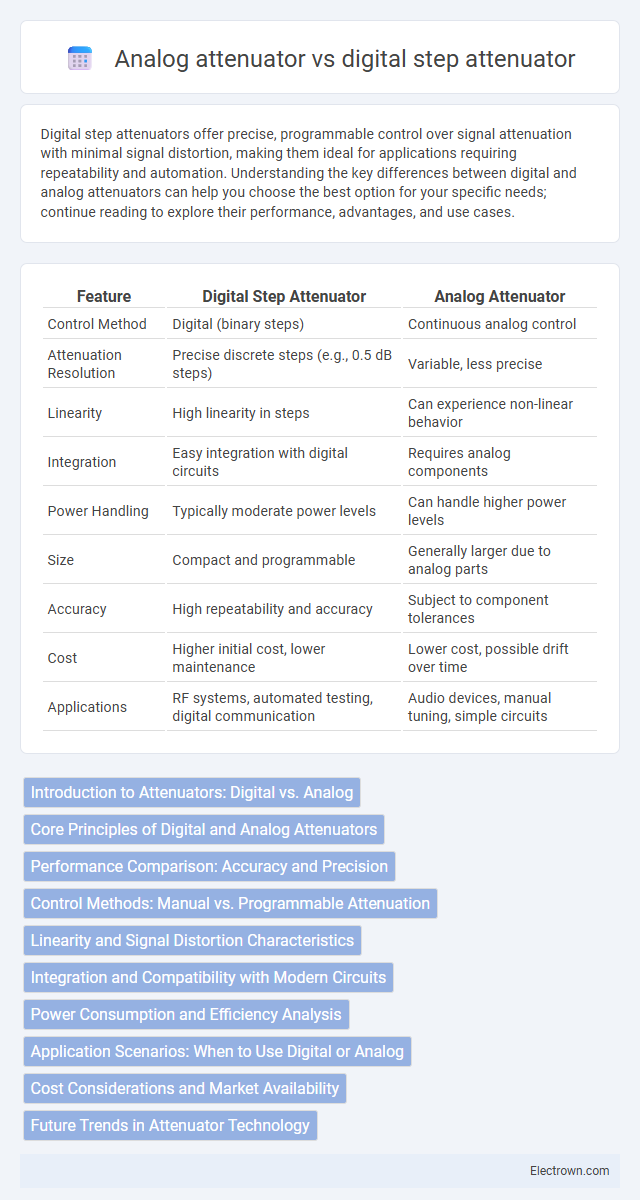Digital step attenuators offer precise, programmable control over signal attenuation with minimal signal distortion, making them ideal for applications requiring repeatability and automation. Understanding the key differences between digital and analog attenuators can help you choose the best option for your specific needs; continue reading to explore their performance, advantages, and use cases.
Table of Comparison
| Feature | Digital Step Attenuator | Analog Attenuator |
|---|---|---|
| Control Method | Digital (binary steps) | Continuous analog control |
| Attenuation Resolution | Precise discrete steps (e.g., 0.5 dB steps) | Variable, less precise |
| Linearity | High linearity in steps | Can experience non-linear behavior |
| Integration | Easy integration with digital circuits | Requires analog components |
| Power Handling | Typically moderate power levels | Can handle higher power levels |
| Size | Compact and programmable | Generally larger due to analog parts |
| Accuracy | High repeatability and accuracy | Subject to component tolerances |
| Cost | Higher initial cost, lower maintenance | Lower cost, possible drift over time |
| Applications | RF systems, automated testing, digital communication | Audio devices, manual tuning, simple circuits |
Introduction to Attenuators: Digital vs. Analog
Digital step attenuators provide precise, programmable signal reduction through discrete steps, offering repeatability and integration with modern digital systems. Analog attenuators deliver continuous attenuation by varying resistance or impedance, enabling smooth signal adjustment but lacking the exact control of digital counterparts. Your choice between digital and analog attenuators depends on the required accuracy, control method, and application environment.
Core Principles of Digital and Analog Attenuators
Digital step attenuators operate using precise, discrete resistance values controlled by digital signals, allowing for accurate and repeatable attenuation levels with minimal signal distortion. Analog attenuators rely on variable resistive elements, such as potentiometers or voltage-controlled devices, to provide continuous adjustment of signal amplitude but may introduce more noise and non-linearity. The core principle differences lie in digital attenuation's scalability and programmability versus analog's simplicity and smooth control characteristics.
Performance Comparison: Accuracy and Precision
Digital step attenuators offer superior accuracy and precision compared to analog attenuators due to their discrete, calibrated attenuation steps controlled by digital signals. Analog attenuators can suffer from component tolerances and temperature variations, leading to less consistent performance and drift over time. Your choice of digital attenuation ensures more repeatable and reliable signal control, critical for high-performance RF applications.
Control Methods: Manual vs. Programmable Attenuation
Digital step attenuators utilize programmable attenuation control, allowing precise adjustments through microcontrollers or software interfaces, which enhances automation and repeatability in signal management. Analog attenuators rely on manual control methods, such as variable resistors or mechanical dials, offering simplicity but less flexibility and accuracy compared to digital solutions. Your choice depends on whether you prioritize programmable precision with digital step attenuators or straightforward manual operation with analog attenuators.
Linearity and Signal Distortion Characteristics
Digital step attenuators exhibit superior linearity due to their discrete control elements, minimizing signal distortion compared to analog attenuators that rely on continuously variable resistive or potentiometric components. Analog attenuators often introduce nonlinearities and harmonic distortion as signal levels vary, impacting high-fidelity audio and RF applications. The precise, repeatable attenuation steps in digital attenuators ensure consistent signal integrity, making them preferable for applications demanding minimal signal degradation and accurate gain control.
Integration and Compatibility with Modern Circuits
Digital step attenuators offer superior integration with modern circuits due to their compatibility with digital control interfaces such as SPI and I2C, enabling seamless communication with microcontrollers and digital signal processors. Analog attenuators, relying on variable resistors or potentiometers, lack this level of digital interoperability, making them less adaptable for automated systems and complex signal processing environments. The precise and repeatable attenuation steps of digital step attenuators enhance their suitability for applications requiring programmable signal attenuation within modern integrated circuit designs.
Power Consumption and Efficiency Analysis
Digital step attenuators typically consume less power than analog attenuators due to their discrete switching elements and low quiescent current, enhancing overall efficiency in signal control applications. Analog attenuators rely on continuous variable resistive or active elements, often leading to higher power dissipation and reduced energy efficiency. Your choice between the two should consider digital step attenuators for low-power, high-efficiency scenarios where precise attenuation steps are required.
Application Scenarios: When to Use Digital or Analog
Digital step attenuators excel in scenarios requiring precise, repeatable, and programmable attenuation levels, making them ideal for automated test systems, communication equipment, and digital signal processing applications. Analog attenuators offer smooth and continuous attenuation control, preferred in audio devices, RF signal conditioning, and applications where fine-tuning by human operators is essential. Your choice depends on whether you need digital control with high accuracy or analog smoothness and simplicity in attenuation adjustment.
Cost Considerations and Market Availability
Digital step attenuators generally have higher upfront costs due to complex integrated circuits but offer precise attenuation control and programmability, making them favorable in advanced electronic applications. Analog attenuators are typically more affordable and widely available in various passive component forms, appealing to cost-sensitive projects requiring simpler designs. Market availability for digital step attenuators is growing rapidly with the rise of digital signal processing, while analog attenuators remain more accessible across broad industrial and consumer applications.
Future Trends in Attenuator Technology
Future trends in attenuator technology highlight a shift towards digital step attenuators due to their superior precision, repeatability, and programmability compared to analog attenuators. Advances in semiconductor fabrication and MEMS technology are enabling increasingly compact, energy-efficient digital attenuators with enhanced linearity and extended frequency ranges. Your choice in attenuation components will likely benefit from these innovations, offering improved integration with digital control systems and adaptive signal processing.
Digital step attenuator vs analog attenuator Infographic

 electrown.com
electrown.com